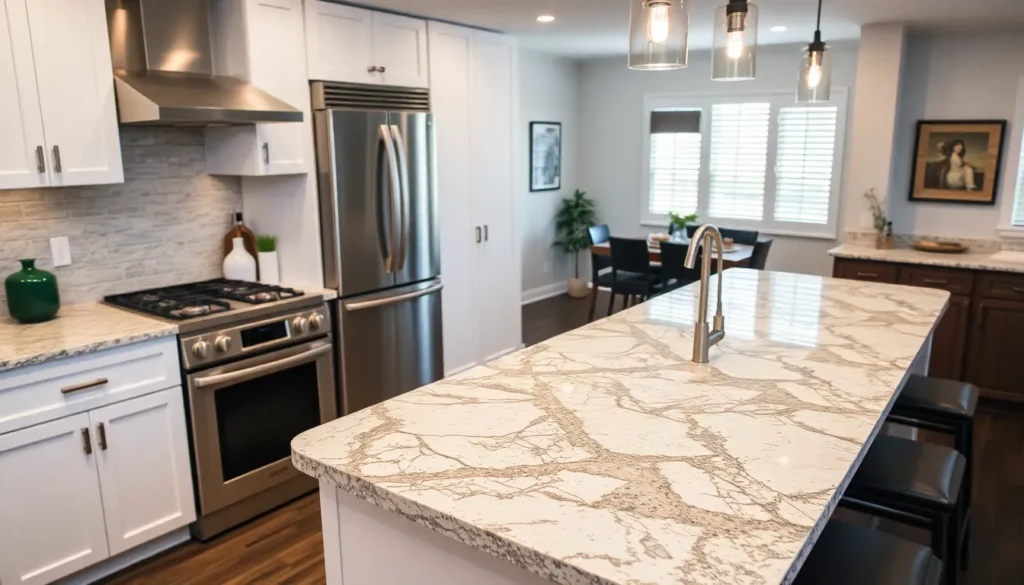We’ve all stood in our kitchens dreaming of the perfect countertop that’ll transform our cooking space from ordinary to extraordinary. Your countertop isn’t just a work surface – it’s the foundation that defines your kitchen’s entire aesthetic and functionality.
Whether you’re planning a complete kitchen renovation or simply looking to upgrade your existing space, choosing the right countertop material can feel overwhelming. From timeless granite and elegant marble to modern quartz and budget-friendly laminate options, today’s market offers countless possibilities that cater to every style preference and budget range.
We’ll guide you through the most popular countertop materials, explore creative design ideas, and help you discover which option best suits your lifestyle and cooking habits. Get ready to transform your kitchen into the heart of your home with countertop answers that combine beauty, durability, and practicality.
Granite Countertops: The Timeless Classic Choice
Granite stands as the gold standard for kitchen countertops, offering unmatched elegance that never goes out of style. We’ve helped countless homeowners discover why granite remains their top choice after decades of kitchen design trends.
Natural Beauty and Unique Patterns
Each granite slab tells its own geological story through distinctive veining and color variations. Formed deep within the earth over millions of years, granite displays natural patterns that can’t be replicated in manufactured materials. Popular color options include classic whites like Colonial White and Kashmir White, dramatic blacks such as Absolute Black and Black Galaxy, and warm earth tones like Giallo Ornamental and Santa Cecilia.
Movement patterns range from subtle speckled designs to bold flowing veins. Some granite varieties feature consistent granular textures, while others showcase dramatic swirls and waves that create stunning focal points. Brazilian granite often displays the most vibrant patterns, while Indian granite typically offers more uniform appearances perfect for contemporary kitchens.
Matching adjacent slabs requires careful selection during installation. We recommend viewing multiple slabs at the fabricator’s yard to ensure consistent color and pattern flow across your entire countertop surface. Bookmatching techniques can create mirror images at seams, while random matching provides a more natural, organic look.
Durability and Heat Resistance
Granite ranks 6 to 7 on the Mohs hardness scale, making it highly resistant to scratches and chips. This natural stone withstands daily kitchen activities including cutting, chopping, and food preparation without showing wear. Diamond blades are required to cut granite, demonstrating its exceptional hardness compared to other countertop materials.
Heat resistance allows placement of hot cookware directly on granite surfaces. Granite can handle temperatures up to 1,200°F without damage, though we still recommend using trivets for extremely hot items to prevent thermal shock. Cast iron skillets, hot casserole dishes, and steaming pots won’t leave marks or cause cracking when placed on properly installed granite countertops.
Impact resistance makes granite ideal for busy family kitchens. Heavy appliances, dropped dishes, and everyday kitchen accidents rarely cause damage to granite surfaces. Properly supported granite countertops can bear important weight, making them perfect for kitchen islands and breakfast bars where people gather and lean.
Maintenance Requirements and Sealing
Sealing granite countertops every 12 to 18 months preserves their stain resistance. Quality granite sealers penetrate the stone’s pores, creating a protective barrier against liquids and stains. We recommend performing the water test annually: if water beads on the surface, your sealer is still effective; if it absorbs within 15 minutes, resealing is needed.
Daily cleaning requires only mild soap and water or granite exact cleaners. Avoid acidic cleaners like vinegar, lemon juice, or generic household cleaners that can dull the granite’s polish over time. Microfiber cloths work best for daily wiping, while soft scrub brushes handle stubborn spills without scratching the surface.
Professional polishing every 5 to 10 years restores granite’s original luster. Minor etches, scratches, or dull spots can be professionally refinished without full replacement. Regular maintenance costs typically range from $200 to $500 annually, making granite a cost effective long term investment for your kitchen renovation.
Quartz Countertops: Engineered Perfection

We’ve moved from natural granite to engineered quartz, a material that combines the beauty of stone with modern manufacturing precision. Quartz countertops deliver consistent quality and performance that many homeowners find appealing for their kitchen renovations.
Non-Porous Surface Benefits
Stain resistance tops the list of quartz advantages, thanks to its completely non-porous surface that prevents liquids from penetrating the material. Spills from oil, wine, juice, and other common kitchen substances wipe away effortlessly without leaving permanent marks or stains.
Bacteria resistance comes naturally with quartz’s sealed surface, which doesn’t harbor germs or allow bacterial growth like porous materials can. We don’t need to worry about deep cleaning or sanitizing beyond regular wiping.
Sealing requirements become obsolete with quartz countertops, unlike natural stones that demand periodic resealing every 12 to 18 months. This engineered surface maintains its protective qualities throughout its lifespan without additional treatments.
Consistent Color and Pattern Options
Color uniformity across entire slabs ensures our kitchen maintains a cohesive look without the natural variations found in granite or marble. Each quartz slab matches perfectly with others from the same batch, eliminating concerns about pattern flow during installation.
Pattern variety ranges from solid colors to designs that mimic natural stone, concrete, or even fabric textures. We can choose from hundreds of options including classic whites, bold blacks, and contemporary grays with subtle veining.
Design flexibility allows us to achieve exact aesthetic goals since manufacturers can control the appearance of each slab. Whether we prefer minimalist solid colors or dramatic marble-look patterns, quartz delivers exactly what we envision.
Low Maintenance Appeal
Durability standards make quartz highly resistant to scratches, chips, and daily wear that busy kitchens demand. This engineered stone withstands decades of use while maintaining its original appearance and functionality.
Cleaning simplicity requires only mild soap and water for daily maintenance, with no special cleaners or treatments needed. We can tackle most spills and messes with standard household cleaning products without damaging the surface.
Heat tolerance protects against moderate temperature exposure, though we should still use trivets or hot pads for extremely hot cookware. While quartz handles everyday kitchen heat well, direct contact with very hot items can potentially cause damage to the resin binders.
Marble Countertops: Luxurious Elegance
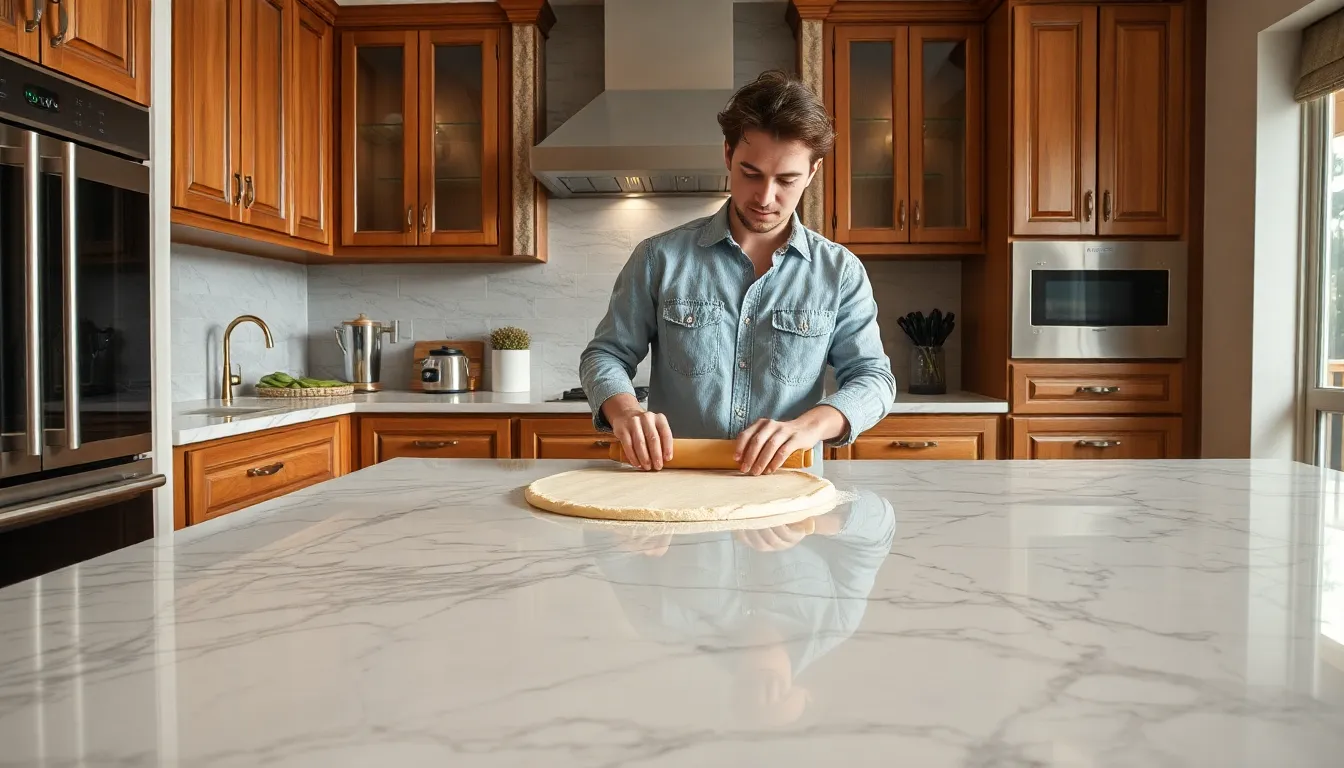
Moving beyond engineered options, we discover that marble countertops bring unparalleled sophistication to kitchen design. Natural stone’s timeless appeal continues to make marble a preferred choice for high-end kitchen renovations.
Stunning Veining and Natural Appeal
Distinctive patterns and swirls create marble’s signature look, formed by mineral deposits over millions of years. Each slab offers unique veining that cannot be replicated by any engineered material, giving your kitchen a truly one-of-a-kind appearance. Natural color variations range from classic Carrara marble’s subtle gray veining to Calacatta marble’s bold, dramatic patterns against pristine white backgrounds.
Quarried directly from the earth, marble showcases nature’s artistry in every square inch. We find that different marble types provide various design possibilities, allowing homeowners to match their aesthetic preferences with available veining styles. Visual appeal reaches its peak when marble’s natural patterns become the focal point of sophisticated kitchen designs.
Ideal for Baking Enthusiasts
Cool surface temperatures make marble countertops perfect for pastry work and bread making. Professional bakers consistently choose marble for its temperature retention properties, which help maintain dough consistency during preparation. Rolling out delicate pastries becomes effortless on marble’s naturally cool surface, preventing butter from melting too quickly.
Home chefs appreciate how marble keeps pastry dough at optimal temperatures for working. Temperature stability allows for better control when creating flaky pie crusts, delicate croissants, and artisan bread. Many culinary professionals consider marble an essential tool for serious baking endeavors.
Care Considerations and Etching Concerns
Porous nature requires marble countertops to receive regular sealing every 12 to 18 months for optimal protection. Acidic substances like lemon juice, vinegar, wine, and tomato sauce can cause etching, which appears as dull spots or marks on the surface. Common kitchen ingredients pose the greatest threat to marble’s polished finish.
| Maintenance Requirement | Frequency | Purpose |
|---|---|---|
| Sealing | 12-18 months | Stain protection |
| pH-neutral cleaning | Daily | Surface care |
| Professional polishing | As needed | Restore luster |
Gentle cleaning with pH-neutral products helps preserve marble’s appearance over time. Heavy use may result in visible scratches, making careful handling essential for maintaining the stone’s beauty. We recommend avoiding harsh chemicals and acidic cleaners to prevent permanent damage to your marble investment.
Butcher Block Countertops: Warm Wood Appeal
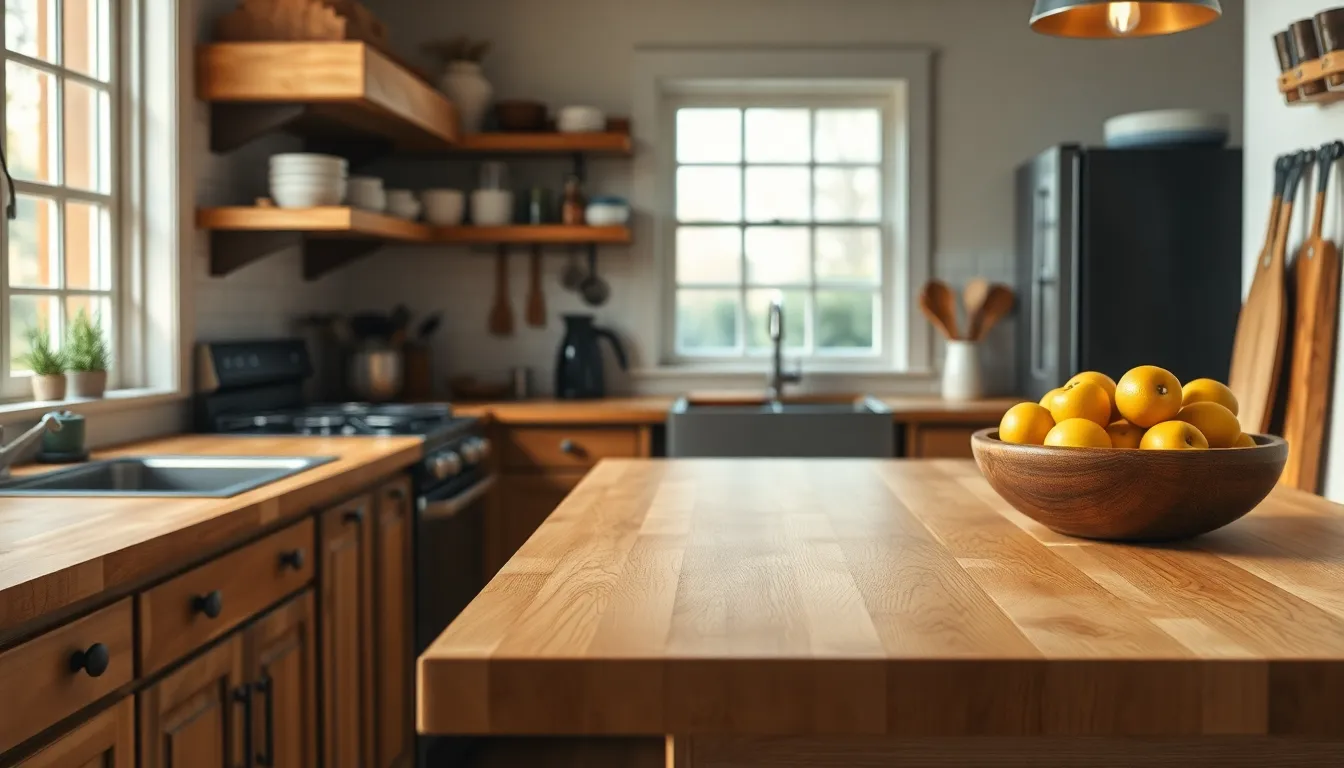
Butcher block countertops bring natural warmth and rustic charm to kitchen spaces through their distinctive wood grain patterns. These countertops consist of glued wood strips that create visually appealing textures while maintaining affordability compared to premium stone materials.
Natural Wood Species Options
Maple stands out as the most popular choice for butcher block countertops due to its light color and exceptional durability. Cherry wood develops a rich, reddish patina over time that adds character to traditional kitchen designs. Oak provides distinctive grain patterns and strength that make it suitable for heavy kitchen use. Walnut offers dark chocolate tones and premium aesthetics for luxury kitchen renovations.
Each wood species brings unique characteristics to your countertop selection. Maple’s tight grain structure resists bacteria naturally while cherry’s natural oils provide built in protection. Oak’s pronounced grain creates dramatic visual interest and walnut’s density ensures long lasting performance in busy kitchens.
Budget-Friendly Installation
Butcher block countertops cost significantly less than granite or quartz alternatives while delivering comparable functionality. Installation expenses remain minimal since these countertops can be cut and fitted using standard woodworking tools. Professional installation typically costs 50 to 70 percent less than stone countertop projects.
DIY installation becomes achievable for homeowners with basic carpentry skills and standard workshop equipment. Finishing or staining the butcher block before installation protects the wood during the mounting process. Unfinished butcher blocks require installation within one week to prevent warping and dimensional changes.
Regular Oiling and Maintenance Needs
| Maintenance Task | Frequency | Method |
|---|---|---|
| Daily Cleaning | As needed | Damp cloth with dish soap |
| Mineral Oil Application | First month weekly, then monthly | Apply thin coat, let absorb |
| Surface Stain Removal | When needed | Razor blade or dough scraper |
| Deep Stain Sanding | Rarely | 180 and 220 grit sandpaper |
Cleaning butcher block countertops requires only a damp cloth or old washcloth with water and dish soap for daily maintenance. Liquids should never stand on the surface to prevent staining and warping damage. Surface stains respond well to gentle scraping with a razor blade or dough scraper for immediate removal.
Oiling maintains the wood’s natural moisture content and prevents cracking or splitting over time. Mineral oil application should occur weekly during the first month and monthly thereafter for optimal protection. Sticky surfaces after oiling indicate excess application and require cleaning with grease cutting detergent to restore proper texture.
Concrete Countertops: Industrial Modern Style
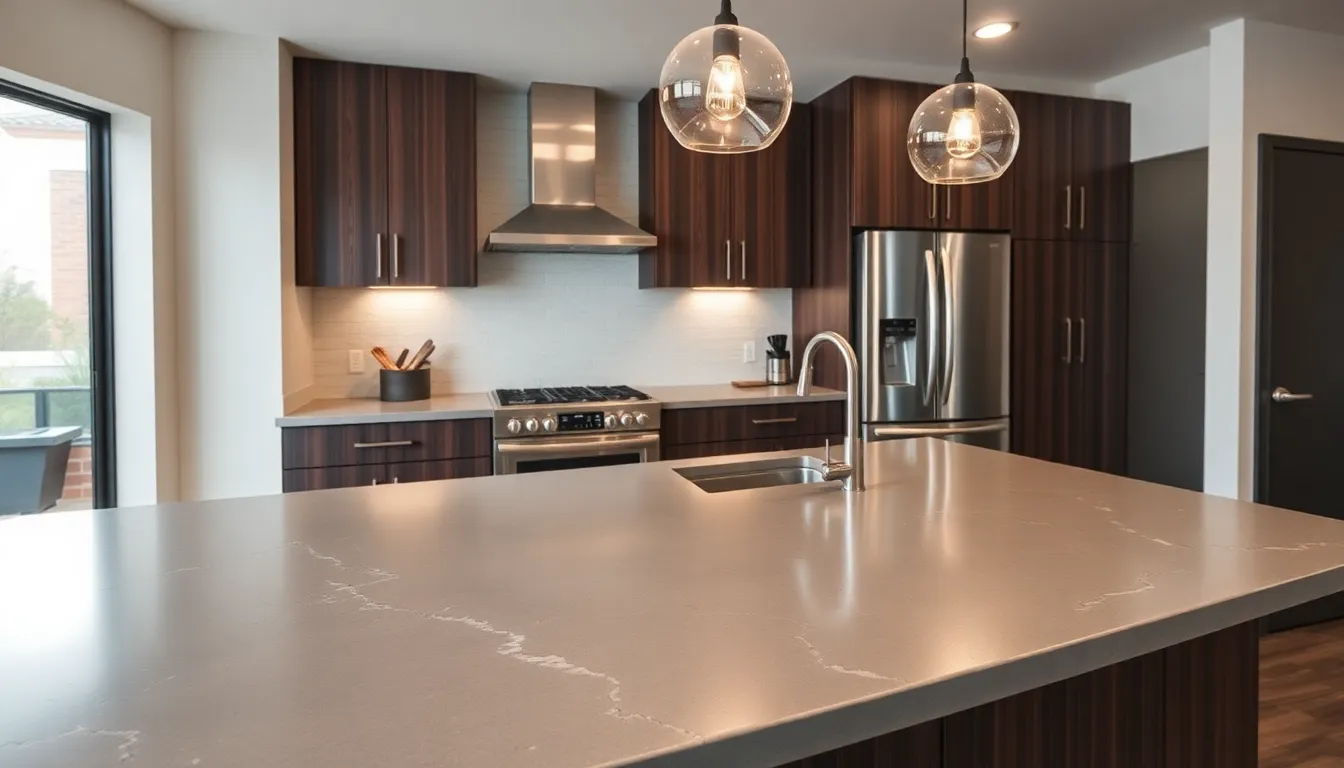
Concrete countertops deliver raw authenticity and rugged appeal that perfectly captures the industrial modern aesthetic. We’ve seen these surfaces become increasingly popular among homeowners seeking an urban, utilitarian look that complements exposed brick, steel beams, and wood elements.
Customizable Colors and Finishes
Colors range far beyond the classic gray that defines industrial kitchens. We can tint concrete to achieve virtually any hue, from warm earth tones to bold contemporary shades that match your design vision. Light gray remains the most popular choice for authentic industrial styling, especially when paired with stainless steel appliances and dark wood cabinetry.
Finishes offer incredible versatility to suit different design preferences. Smooth, polished surfaces create a refined minimalist appearance, while textured finishes deliver an earthy, handcrafted feel that adds visual interest. Custom mix-ins like glass chips or colored aggregates let us create unique visual effects that make each countertop truly distinctive.
Surface treatments can be adjusted during the finishing process to achieve matte or glossy appearances. Polishing techniques allow us to control the final sheen level, ensuring the countertop complements your overall kitchen aesthetic perfectly.
DIY Installation Possibilities
Installation can be tackled as a DIY project by homeowners with basic construction skills. We recommend starting with simple layouts before attempting complex shapes or integrated features. The process involves constructing a precise mold, mixing and pouring concrete, then finishing through polishing and sealing.
Resources for DIY concrete countertop projects are widely available online. Step-by-step guides, video tutorials, and material lists make this an accessible option for budget-conscious renovators. Professional installation remains available for those preferring expert craftsmanship or dealing with complex kitchen layouts.
Cost savings from DIY installation can be substantial compared to professional fabrication. Materials typically cost a fraction of what you’d pay for natural stone, making concrete an attractive option for extensive kitchen renovations.
Unique Texture and Character
Each concrete countertop develops its own personality through the handcrafted process. Natural variations in the material create subtle patterns, occasional air bubbles, and minor imperfections that add authentic character. These unique qualities appeal to homeowners seeking individuality rather than manufactured uniformity.
Texture variations occur naturally during the curing process. Surface patterns emerge organically, creating one-of-a-kind pieces that can’t be replicated exactly. This artisanal quality connects your kitchen to traditional craftsmanship while maintaining a thoroughly modern appearance.
Character develops over time as the concrete ages and develops a natural patina. Minor wear patterns and subtle color changes enhance the industrial aesthetic, creating surfaces that become more beautiful with use rather than showing deterioration.
Stainless Steel Countertops: Professional Kitchen Look

Stainless steel countertops offer a sleek, modern aesthetic that transforms any kitchen into a professional workspace. We’ve seen countless homeowners choose this material for its clean lines and industrial appeal.
Hygienic and Easy to Clean
Stainless steel’s non-porous surface makes it naturally resistant to bacteria and germs, ensuring your kitchen stays sanitary. We appreciate how simple daily maintenance becomes with just soap and water cleaning. Unlike other materials, stainless steel won’t harbor harmful microorganisms in tiny crevices or pores.
Cleaning becomes effortless since spills and food residue wipe away instantly without leaving permanent marks. We find that busy families love how quickly they can sanitize these surfaces between meal preparations. Regular maintenance requires only basic household cleaners, making stainless steel one of the most practical choices for active kitchens.
Heat and Stain Resistance
Heat resistance stands out as one of stainless steel’s greatest advantages, allowing you to place hot pots and pans directly on the surface. We’ve observed that this durability prevents damage from everyday cooking activities like removing items from the oven or stovetop. Temperature fluctuations won’t cause cracking or discoloration like they might with other countertop materials.
Stain resistance ensures your countertops maintain their appearance even after years of heavy use. We notice that common kitchen stains from coffee, wine, or cooking oils simply wipe away without penetrating the surface. This resilience makes stainless steel ideal for households that do extensive cooking and food preparation.
Commercial Kitchen Aesthetic
Commercial kitchen aesthetics bring professional sophistication to residential spaces through stainless steel’s sleek appearance. We see this material creating a cohesive look when paired with stainless steel appliances like refrigerators and range hoods. Restaurant quality design becomes achievable in home kitchens without the commercial price tag.
Modern design trends embrace the industrial look that stainless steel provides, especially in contemporary and minimalist kitchen styles. We recommend this material for homeowners who want their kitchen to feel like a professional workspace where serious cooking happens. The reflective surface also helps brighten darker kitchens by bouncing light around the space.
Tile Countertops: Versatile Design Options
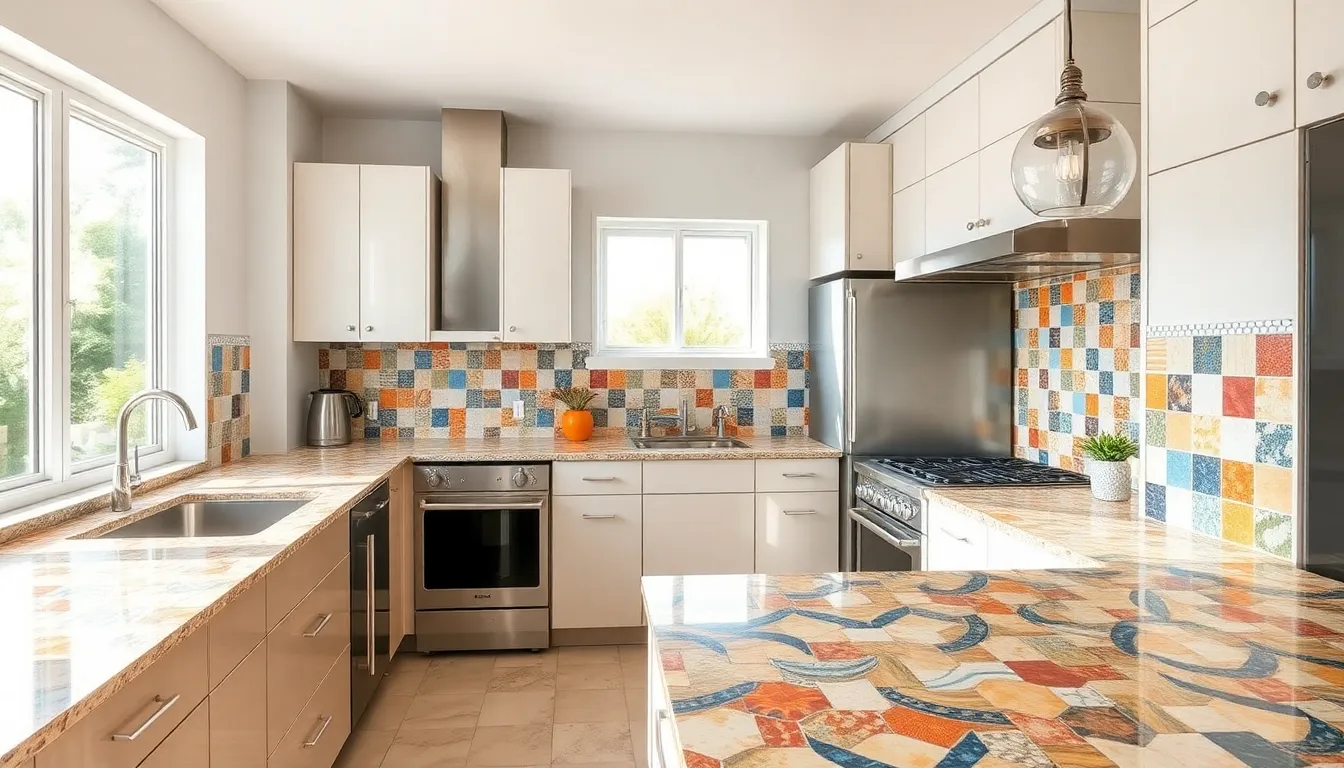
Tile countertops offer exceptional flexibility in kitchen design while delivering durability at an affordable price point. We’ll explore the diverse options available to create stunning kitchen surfaces that match your style and budget.
Ceramic and Porcelain Choices
Ceramic tile stands out as an affordable option that’s perfect for homeowners seeking easy installation and diverse design possibilities. We find ceramic tiles available in countless colors and patterns, making them ideal for creating custom looks that complement any kitchen aesthetic. Installation costs remain low since many homeowners can tackle ceramic tile projects themselves with basic DIY skills.
Porcelain tile delivers superior durability compared to ceramic options, offering enhanced resistance to stains and scratches that make it suitable for high-traffic kitchen areas. We recommend porcelain for busy households where countertops endure heavy daily use. Maintenance requirements stay minimal while performance exceeds expectations over time.
Glass tile creates sleek, reflective finishes that enhance lighting throughout your kitchen space. We appreciate how glass tiles amplify natural and artificial light, making smaller kitchens appear more spacious and brighter.
Natural stone tile provides the luxurious appearance of granite or marble but with simpler installation processes and easier maintenance routines. We suggest natural stone tiles for homeowners who want premium aesthetics without the complexity of slab installation.
Metallic tile incorporates contemporary finishes that deliver modern, industrial aesthetics perfect for urban kitchen designs. We see metallic tiles working exceptionally well in loft-style spaces and contemporary homes.
Creative Pattern Possibilities
Mosaics enable intricate designs using small tiles that add important visual interest to any kitchen countertop. We create stunning focal points by combining different tile sizes, colors, and textures in mosaic arrangements. Small tiles allow for curved edges and complex patterns that larger tiles cannot achieve.
Accent patterns use contrasting tile colors to establish eye-catching borders and design elements throughout your countertop surface. We recommend incorporating accent tiles around sink areas, breakfast bars, and kitchen islands to define different zones. Contrasting colors create visual depth and prevent monotonous surfaces.
Geometric patterns incorporate modern or retro looks through strategic tile placement and color combinations. We design hexagonal, herringbone, and diamond patterns that transform ordinary countertops into artistic statements. Angular designs work particularly well in contemporary kitchens where clean lines dominate the aesthetic.
Grout Maintenance Considerations
Grout sealer application protects against stains while making routine cleaning significantly easier throughout your tile countertop’s lifespan. We recommend applying grout sealer immediately after installation and reapplying annually to maintain optimal protection. Sealed grout resists moisture penetration and prevents bacteria growth in the grout lines.
Regular cleaning with mild detergent prevents dirt buildup that can discolor grout lines and compromise your countertop’s appearance. We suggest weekly cleaning sessions using non-abrasive cleaners specifically designed for tile surfaces. Consistent maintenance prevents deep staining that requires professional restoration.
Regrouting becomes necessary approximately every decade or when grout lines show important wear, cracking, or discoloration. We evaluate grout condition regularly to determine optimal regrouting timing. Fresh grout restores your tile countertop’s original appearance and maintains structural integrity around each tile.
Laminate Countertops: Affordable Style Solutions

Laminate countertops have evolved far beyond their reputation as basic budget materials. We’re seeing remarkable transformations in laminate technology that deliver sophisticated aesthetics without the premium price tag.
Modern Design Improvements
Today’s laminate surfaces feature advanced printing technology that creates incredibly realistic stone and wood textures. We can find laminate options that convincingly mimic granite veining, marble patterns, and natural wood grains with remarkable detail and depth.
High-definition laminate finishes now include textured surfaces that enhance both visual appeal and functionality. These innovations allow us to achieve the look of expensive materials while maintaining laminate’s practical benefits.
Anti-fingerprint coatings represent another important advancement in laminate technology. We no longer need to worry about constant cleaning since these surfaces resist smudges and maintain their appearance throughout daily use.
Color consistency across entire kitchen installations ensures seamless design flow. Unlike natural materials with inherent variations, laminate provides uniform appearance that creates cohesive kitchen aesthetics.
Easy Installation Process
Laminate installation requires minimal specialized tools and can often be completed as a weekend project. We appreciate that many homeowners can tackle this renovation without hiring professional contractors.
Pre-fabricated laminate sections fit standard cabinet dimensions and reduce installation complexity. These ready-to-install options eliminate the need for precise measuring and cutting that other materials require.
Adhesive application methods have simplified dramatically with modern contact cement formulations. We can achieve strong, lasting bonds using straightforward techniques that don’t require extensive experience.
Template systems guide accurate cutting and fitting around sinks, cooktops, and other fixtures. These tools help us achieve professional-looking results even during DIY installations.
Cost-Effective Kitchen Updates
Budget considerations make laminate an attractive choice for kitchen renovations, typically costing 60-70% less than natural stone alternatives. We can achieve dramatic kitchen transformations without overwhelming renovation expenses.
Maintenance costs remain minimal throughout laminate’s lifespan since these surfaces don’t require sealing or professional refinishing. Our long-term ownership expenses stay predictable and low.
Replacement flexibility allows us to update kitchen styles affordably as design preferences change. We’re not locked into expensive materials that make future renovations financially prohibitive.
Installation savings compound the material cost advantages since many homeowners can complete the work themselves. Professional installation fees, when needed, remain significantly lower than those required for stone or solid surface materials.
Recycled Glass Countertops: Eco-Friendly Innovation

We’re seeing growing interest in sustainable kitchen materials that combine environmental responsibility with stunning aesthetics. Recycled glass countertops represent the perfect fusion of eco-consciousness and modern design innovation.
Sustainable Material Benefits
Recycled glass countertops transform waste glass into beautiful functional surfaces, reducing landfill waste significantly through their innovative manufacturing process. Crushed glass gets embedded in materials like cement or acrylic, giving new life to discarded bottles and windows that would otherwise contribute to environmental waste.
Production processes for these countertops generate a lower carbon footprint compared to traditional materials such as granite or marble. We’re supporting circular economy principles when we choose recycled glass, as manufacturers divert thousands of pounds of waste glass from landfills each year to create these sustainable surfaces.
Environmental impact reduction extends beyond waste diversion, as the manufacturing process requires less energy than quarrying and processing natural stone materials. Local glass waste often gets sourced for production, reducing transportation emissions and supporting regional sustainability efforts.
Colorful and Unique Appearance
Recycled glass countertops offer vibrant aesthetics that natural stone simply cannot match, with glass fragments available in countless colors and sizes. Design possibilities become virtually limitless when manufacturers can incorporate colored glass pieces, creating custom patterns that reflect personal style preferences.
Kitchen and bathroom spaces gain distinctive character through the sparkling, light-reflecting properties of embedded glass fragments. We can choose from subtle earth tones for understated elegance or bold, bright colors for dramatic visual impact that serves as a conversation starter.
Pattern variations range from uniform glass distribution to artistic arrangements that create exact visual effects like waves, gradients, or mosaic-inspired designs. Each countertop becomes a unique piece of functional art, as no two installations look exactly the same due to the random distribution of glass particles.
Durability and Maintenance
Recycled glass countertops deliver exceptional durability through their resistance to scratches, stains, and heat damage. Heavy kitchen use won’t compromise their appearance over time, as these surfaces maintain their integrity under normal cooking activities and daily wear.
Heat resistance allows hot cookware to be placed directly on the surface without causing damage, similar to natural stone materials. We can confidently use these countertops for all cooking tasks without worrying about thermal shock or discoloration from temperature changes.
| Maintenance Requirement | Cement-Binder | Acrylic-Binder |
|---|---|---|
| Periodic Sealing | Required | Not Required |
| Daily Cleaning | Mild soap and water | Mild soap and water |
| Stain Resistance | High (when sealed) | Naturally high |
| Porosity | Low | Non-porous |
Cleaning routines stay simple with mild soap and water being sufficient for daily maintenance. Non-porous surfaces in acrylic-binder varieties resist bacteria and stains naturally, while cement-binder options may require periodic sealing to maintain optimal protection.
Lifespan extension comes through proper care practices, and the easy cleaning process helps busy households maintain beautiful countertops without intensive maintenance schedules or specialized cleaning products.
Solid Surface Countertops: Seamless Integration

Solid surface countertops deliver the perfect blend of functionality and modern aesthetics for today’s kitchens. We’ll explore how these engineered materials create continuous surfaces that transform your workspace into a sleek, unified environment.
Corian and Similar Materials
Engineered materials like Corian represent the pinnacle of solid surface technology, combining acrylic or polyester resins with mineral fillers to create durable surfaces. Manufacturing processes enable sheets to be joined with minimal visible seams, making them ideal for large islands or installations requiring a uniform appearance. We appreciate how these materials offer seamless integration that allows for sleek, continuous surfaces with custom curves or built-in backsplashes.
Corian’s nonporous surface resists bacteria and stains naturally, simplifying maintenance and cleaning requirements. Heat and impact resistance varies by product, but many solid surface options offer moderate durability suitable for most residential kitchens. Color and pattern variety gives homeowners extensive options to match preferred style or design schemes, from subtle neutrals to bold contemporary looks.
Repairable Surface Advantages
Surface damage becomes manageable with solid surface countertops, as scratches or minor damages can often be sanded out completely. Restoration techniques allow us to bring back the original finish without noticeable marks, unlike many other countertop materials. Professional repair services can address deeper scratches or burns, extending the lifespan significantly beyond other surface options.
Maintenance simplicity means regular cleaning with mild soap keeps surfaces looking new for years. We find that this repairability factor makes solid surface countertops particularly valuable for busy family kitchens where wear and tear are inevitable. Long term cost savings result from avoiding complete replacement when damage occurs.
Integrated Sink Options
Molded sink integration creates one piece countertop and sink units that eliminate seams where food debris or bacteria might collect. Seamless construction enhances both hygiene and visual continuity throughout the workspace. We love how this integrated approach removes the traditional boundary between countertop and sink areas.
Custom fabrication allows for unique sink shapes and sizes that perfectly match kitchen layouts and user preferences. Installation becomes more streamlined when countertop and sink arrive as a single unit. Cleaning efficiency improves dramatically without crevices or joints that trap dirt and require special attention.
Conclusion
Your perfect countertop awaits discovery among these diverse options we’ve explored. Each material brings its own personality to your kitchen – from granite’s timeless elegance to concrete’s industrial charm and recycled glass’s eco-friendly innovation.
We encourage you to weigh your priorities carefully: budget constraints maintenance preferences durability needs and design vision. Whether you’re drawn to the luxury of marble or the practicality of laminate there’s a solution that’ll transform your kitchen into the heart of your home.
Remember that the best countertop choice is one that fits your lifestyle and cooking habits. Take time to visit showrooms feel different surfaces and envision how each material will work in your daily routine. Your investment in the right countertop will reward you with years of beauty and functionality.
Frequently Asked Questions
What are the most popular kitchen countertop materials?
The most popular kitchen countertop materials include granite, quartz, marble, butcher block, concrete, stainless steel, tile, laminate, recycled glass, and solid surface materials like Corian. Each material offers unique benefits in terms of aesthetics, durability, maintenance requirements, and budget considerations to suit different lifestyle needs and design preferences.
How often do granite countertops need to be sealed?
Granite countertops should be sealed every 12 to 18 months to maintain their stain resistance and preserve their natural beauty. This protective sealing process helps prevent liquids from penetrating the stone’s porous surface. Regular sealing, combined with daily cleaning using mild soap and water, ensures your granite countertops remain beautiful and functional for years.
Are quartz countertops better than granite?
Quartz countertops offer consistent patterns, non-porous surfaces that resist stains and bacteria, and require no sealing maintenance. Granite provides unique natural patterns, excellent heat resistance, and classic elegance. The choice depends on your priorities: quartz for low maintenance and consistency, granite for natural beauty and heat tolerance. Both are durable, long-lasting options.
Do marble countertops stain easily?
Yes, marble countertops are porous and prone to staining and etching from acidic substances like lemon juice, wine, or vinegar. They require sealing every 12-18 months and immediate cleanup of spills. Despite maintenance challenges, marble offers unmatched elegance and is ideal for baking due to its naturally cool surface temperature.
How much do butcher block countertops cost compared to stone?
Butcher block countertops are significantly more budget-friendly than stone alternatives, typically costing 60-80% less than granite or quartz. Installation costs are also lower since many homeowners can install them with basic carpentry skills. However, they require regular maintenance including periodic oiling to preserve the wood’s appearance and durability.
Can you put hot pans on stainless steel countertops?
Yes, stainless steel countertops are highly heat-resistant and can withstand hot pots and pans placed directly on their surface without damage. This makes them ideal for busy kitchens and provides the professional workspace feel of commercial kitchens. They also offer excellent hygiene benefits due to their non-porous, bacteria-resistant surface.
Are laminate countertops outdated?
Modern laminate countertops have evolved significantly from basic budget materials. Today’s laminate features advanced printing technology that realistically mimics stone and wood, high-definition finishes, and anti-fingerprint coatings. They cost 60-70% less than natural stone while offering stylish aesthetics and easy maintenance, making them a smart contemporary choice.
How eco-friendly are recycled glass countertops?
Recycled glass countertops are highly eco-friendly, transforming waste glass into beautiful surfaces while reducing landfill waste. The manufacturing process generates a lower carbon footprint than traditional materials, and local glass sourcing minimizes transportation emissions. They offer vibrant aesthetics while supporting sustainable practices and environmental responsibility.
Do tile countertops require special maintenance?
Tile countertops require regular grout maintenance, including sealing and cleaning to prevent staining and maintain appearance. The tiles themselves are durable and easy to clean, but grout lines can collect dirt and bacteria if not properly maintained. Porcelain tiles offer superior stain resistance compared to ceramic options for high-traffic kitchen areas.
What are solid surface countertops made of?
Solid surface countertops are made from engineered materials like Corian, combining acrylic or polyester resins with natural minerals. They create seamless, continuous surfaces that resist bacteria and stains. These nonporous materials are repairable – scratches can be sanded out – and offer integrated sink options for enhanced hygiene and modern aesthetics.

